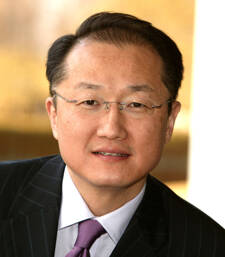A Doctor for Development
At its meeting on April 21, the board of the World Bank, the world’s largest development agency, will choose its next president. Nigeria’s finance minister has been nominated, as has Dr. Jim Yong Kim, an Asian-American. Some nations would like to see a non-American in the president’s seat for once, because Americans have occupied it since 1944, when the bank was established. But Dr. Kim is a stellar choice for the job and a credit to our nation.
Though Dr. Kim did not rise from poverty, his personal achievements are impressive. Born in Seoul and raised in Iowa by highly educated parents, Jim Yong Kim became a Harvard-educated physician and anthropologist, and chair of the Department of Global Health and Social Medicine at Harvard Medical School. He was a highly effective director of the Department of H.I.V./AIDS at the World Health Organization and has co-founded two global health organizations. Partners in Health works with impoverished communities in Haiti, Peru and elsewhere; the Global Health Delivery Project improves public health in disadvantaged populations by maximizing health delivery systems. Dr. Kim, an expert on tuberculosis and a MacArthur Foundation "genius" grant winner, is currently president of Dartmouth College in New Hampshire.
President Obama described the World Bank as "one of the most powerful tools we have to reduce poverty and raise standards of living in some of the poorest countries on the planet." As one who speaks three languages and has traveled widely for decades to improve world health, Dr. Kim’s skills are a glove-like fit for a leadership post customarily held by a business executive.
Latinos on the Move
As Latinos spread across the country, their influence within the U.S. electorate has become more complex and less predictable, as these three examples show.
While Latinos live primarily in the Southwest and Florida, with large populations in New York, New Jersey and Illinois, nearly half still live in just two states: California and Texas. But these geographic patterns are changing. Whereas in 2000, two-thirds of Latinos lived in the 50 counties with the largest Latino populations, 10 years later that percentage had shrunk to 59 percent. And in the interim, the Latino population of nearly every county in America grew; some doubled. These data, based on an analysis of the U.S. Census by the Pew Hispanic Center, contain other surprises.
Who would have thought that three of the 10 counties with the fastest Latino growth rate would be in Georgia? Or that Texas would contain all 10 counties with the highest proportion of Latinos? In eight of those counties, the Latino population exceeds 90 percent of the total. In a representative democracy, that ought to translate into political clout, which has occurred to some extent. When Latino population growth enabled Texas to add four new House seats, the partisan redistricting battles went to the U.S. Supreme Court. After the ruling, only two of the four new districts reflected the Latino growth spurt. Still, Latinos gained influence.
Latino immigration is a third complicating factor. While immigrants themselves cannot vote, citizens tend to cast ballots based on their experience and perception of immigrants. Surprisingly, the percentage of Latinos who are foreign-born is greatest in Maryland, the District of Columbia and Alabama. After the November election, it may become clearer how native-born Latino and non-Hispanic voters took immigrants into consideration at the polls.
Round and Round We Go
Here is a disturbing fact: close to a third of automobile traffic in some urban areas can be attributed to drivers looking for parking spaces. In other words, a notable number of city drivers are not traveling anywhere. They have already arrived and simply cannot find an appropriate place to stop.
Try not to dwell on the absurdity of this daily waltz. The practical problems are cause for worry enough. Higher pollution levels, excessive noise, congested streets—the headaches caused by roaming drivers are legion. And think of the personal costs. Spending your evening behind the wheel circling for parking is a waste of time and money no matter what may be on NPR.
What is city government to do? Restricting parking to local residents is one option. Another: raise parking meter rates to free up valuable street spaces. Yet these are only minor fixes. Cities like San Francisco and New York were not built for heavy car traffic, but they are now home to residents who have grown reliant on personal transportation. The U.S. car culture, nurtured on Eisenhower’s highway system, has infected our cities. The proper solution is to reduce the number of cars through expanded mass transit and the promotion of bicycle use. Congestion pricing, a success in London but twice rejected in New York, also merits further consideration.
Frustrated motorists sometimes like to pray for a parking space. They might also offer up a prayer for city planners. Without their help, we may never escape the urban merry-go-round.









The issues of representation and gerrymandering raise an important question for Catholics: What can we do to promote a democratic environment that fosters participation among all of God's people, especially groups that have been historically excluded or marginalized in the political process? For example, voter turnout for some Latino communities is still low. Catholic teaching already encourages political participation of the faithful - how might these teachings and communications be developed to robustly address Latinos and other politically marginalized people?
Mil gracias!
Political influence aka Ballot Power is absolutely important for Latinos in their new land. While Latinos are rapidly spreading out in numbers all over the USA, a lot more important for them as a group and for the nation as a whole is their unquestionable influence in Educaction, Scientific Research, Government, Arts and Entertainment and above all, Religion.
Your Current Comment does not contain a single sentence on these critical issues. In the Catholic Church in the USA, Latinos represent its largest membership group as we have embraced and strenghten our faith with enthusiasm and conviction.